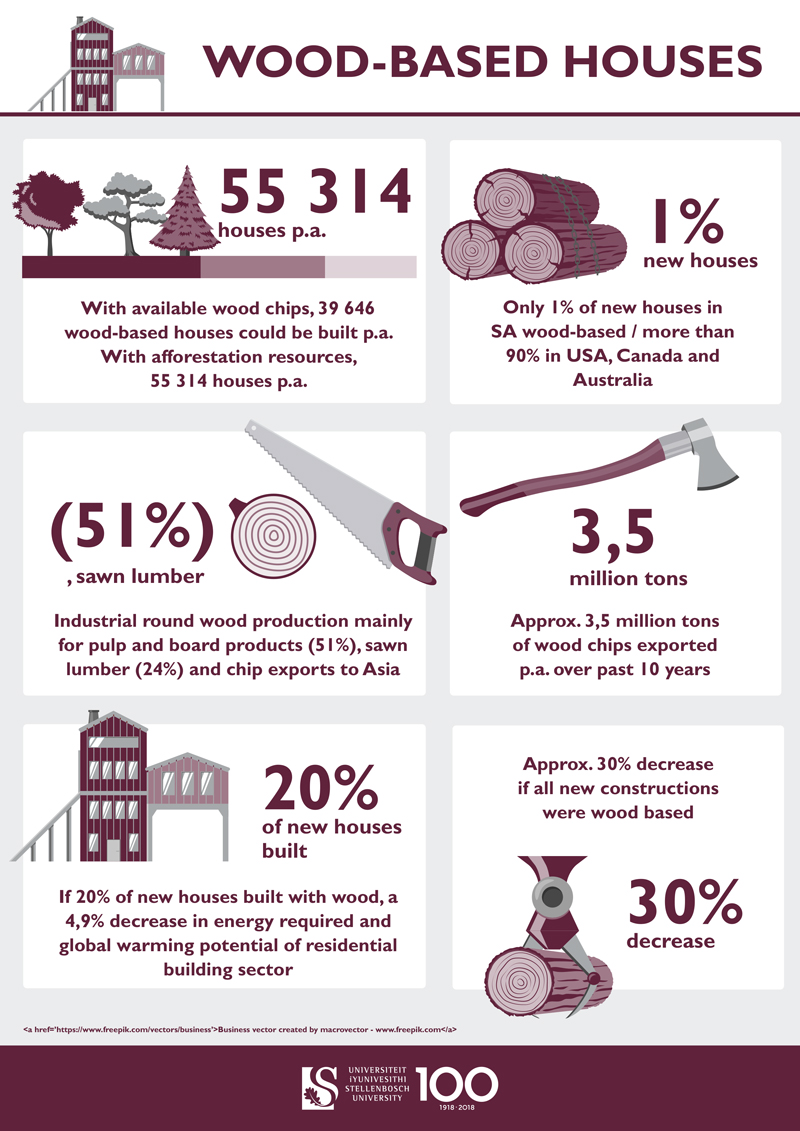Researchers at Stellenbosch University (SU) found that South Africa has sufficient log resource options for a sustainable wood residential building market.
“Our study showed that with the use of wood resources currently exported as chips, as well as planting trees in areas that have been earmarked for afforestation, it will be possible (in the long term) to sustain a future residential building market where all houses are built with wood," says Dr Philip Crafford from SU's Department of Forest and Wood Science. He and colleague Dr Brand Wessels investigated the country's log resources and the potential global warming impact of an increasing wood-based residential building market.
The findings of their study were published in the South African Journal of Science recently.
Crafford says they wanted to determine whether local forest resources would be able to supply the required wood for substantial growth in wood-based residential development in South Africa. To do this, they analysed the residential housing footprint in the country; available log resources for wood-based buildings; and the likely environmental impacts of such a building system.
“Due to the limited forest cover in South Africa, the perception is often that significant increases in the market share of wood-based buildings are not possible (at least from local wood resources). Our study showed that this perception is not correct.
“If we consider only current available wood chips as a resource, 39 646 wood-based houses (30 523 houses and 9123 flats) could be built annually. With the afforestation resources, 55 314 houses (42 586 houses and 12 728 flats) could be constructed each year. That is 1 203 more than the average new buildings in the past 17 years.
Considering both wood chips and afforestation resource potential, close to 95 000 wood-based houses (172% of current supply) could be built annually."
Crafford says that excluding imports and current pulp, board and other log resources, there could be an estimated 6,23 million cubic metres of log resources available for wood house components in the future. This amount of log resources would fill 6 019 Boeing 747s in volume or 55 377 double-decker City Sightseeing busses.
“This clearly indicates the resource potential for an increased wood-based construction market in South Africa."
Despite this potential, only 1% of new houses in the country is wood-based, compared to more than 90% in countries such as the USA, Canada and Australia.
Crafford says South Africa's industrial round wood (saw logs for everyday use) production is mainly to produce pulp and board products (51%), sawn lumber (24%) and chip exports to Asia.
“Over the past 10 years, we exported an average of 3,5 million tons of wood chips annually. Chip exports is the most likely available resource which could potentially be used in the building of wood-based houses."
Regarding the environmental impact of a wood-based building residential market, Crafford says numerous studies have shown that timber is not only renewable, but is also the best performer across most environmental impact factors when compared to alternative building material such as steel and concrete, with particularly good performance in terms of greenhouse gas emissions.
“Our basic modelling analyses show that if 20% of new houses were to be built with wood, the amount of energy/fossil fuels required for production and the global warming potential of the residential building sector could decrease by 4,9%. If all new constructions were wood based, this could decrease by up to 30%.
“This is quite a significant decrease if one considers that in South Africa, it is estimated that the energy used in the construction and use of buildings is responsible for about 27% of the country's total man-made carbon dioxide emissions. Wood-based building materials can help to reduce the environmental footprint of our residential buildings."
Crafford says because South Africa does not have a culture of designing and building with wood, there's a need for further research that includes other impacts such GDP generation, job creation and social and economic comparisons with regard to an increase in wood-based building.
- SOURCE: Crafford, PL & Wessels, CB 2020. South African log resource availability and potential environmental impact of timber construction. South African Journal of Science, Vol. 116(7/8). https://doi.org/10.17159/sajs.2020/6419
FOR MEDIA ENQUIRIES ONLY
Dr Philip Crafford
Department of Forest and Wood Science
Faculty of AgriSciences
Stellenbosch University
Email: pcrafford@sun.ac.za
ISSUED BY
Martin Viljoen
Manager: Media
Corporate Communication & Marketing
Stellenbosch University
Email: viljoenm@sun.ac.za

